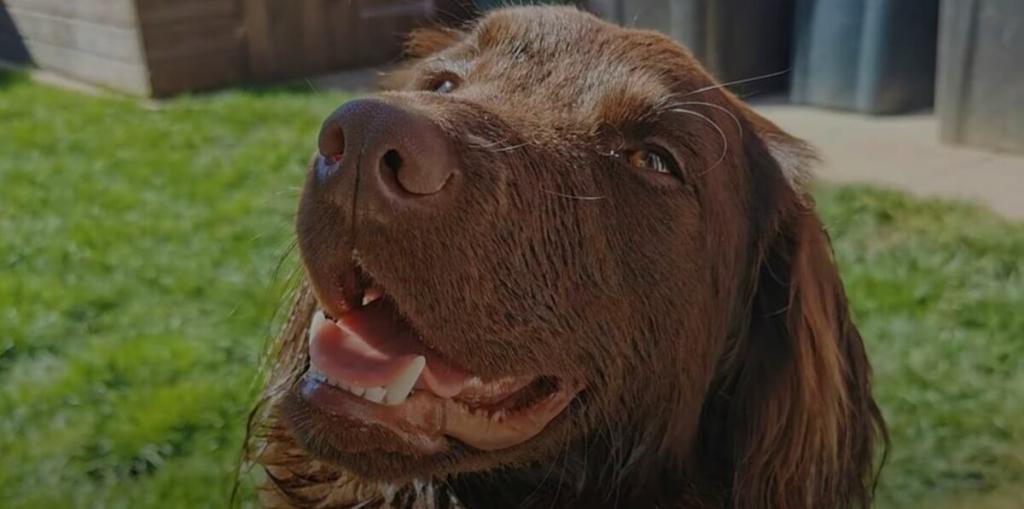In the vast tapestry of dog breeds, the Springador emerges as a vibrant thread, weaving together the Springer Spaniel’s boundless energy with the Labrador Retriever’s steadfast loyalty.
As you consider this dynamic crossbreed for your next canine companion, you’ll find that its versatile nature makes it as adept at frolicking in the fields as it is at curling up by your feet for a quiet evening.
They’re known for their intelligence and eagerness to please, which can make training both a joy and a challenge.
However, before you bring a Springador into your life, it’s essential to understand the nuances of their care— from their exercise needs to their social propensities.
You might wonder if the Springador fits your lifestyle as you weigh the pros and cons. Will their hybrid vigor be a blessing or a hurdle in your daily routine? Only a closer look at their characteristics and requirements will tell.
- Noise Level
- Energy
- Sociability
- Trainability
- Care
- Health
Overall
Summary
The Springador breed typically exhibits moderate noise levels, high energy, sociable behavior, good trainability, moderate care needs, and generally good health.
Springador: Traits, Temperament, and Care Guide
With a blend of the Labrador’s friendliness and the Springer Spaniel’s spirited nature, Springadors are intelligent and energetic dogs that require thoughtful care and consistent training to thrive. As a mixed breed, the Springador dog inherits a dynamic temperament characterized by a friendly disposition tempered by a pronounced hunting drive. You’ll find their energy levels can be unpredictable, necessitating a comprehensive approach to exercise, with a minimum of 1.5 hours of activity daily to mitigate potential repetitive behaviors.
Investing in quality pet products tailored for high-energy breeds will enhance your Springador’s quality of life. Regular health screenings and doggy daycare for socialization are paramount. Their balance of affection, intelligence, and athleticism makes them a rewarding, though demanding, companion.
Exploring the Characteristics of the Springador
Delving into the characteristics of the Springador reveals a robust blend of the Labrador Retriever’s amiable nature and the English Springer Spaniel’s agility and responsiveness. As you consider adding this mix breed to your family, it’s crucial to understand the traits inherited from its parent breeds. Springadors require consistent social interaction to thrive and may develop unwanted behaviors if isolated. Their intelligence and hunting instincts necessitate a training approach rich in positive reinforcement and ample physical activity.
| Trait | Detail | Impact on Ownership |
|---|---|---|
| Weight | 50-90 pounds | Needs space to move |
| Exercise Requirements | At least 1.5 hours daily | Active lifestyle needed |
| Sociability | High; prone to separation anxiety | Requires companionship |
| Training | Straightforward with challenges | Consistent effort needed |
| Suitability as a Pet | Good family pet, not for apartments | Requires a yard or garden |
Understanding the Springador’s mix breed profile will help you create a nurturing environment where this companion can flourish.
Springador: A Comprehensive Profile and Guide
As you consider a Springador your potential new companion, you’ll find they’re an energetic blend, requiring substantial daily exercise to maintain their health and happiness.
Their need for companionship is paramount; prolonged solitude can lead to behavioral issues, underscoring the importance of consistent human interaction.
Training them demands patience and understanding, especially since their mixed lineage can result in varying degrees of the hunting instinct, which may challenge their obedience, particularly in recall scenarios.
Everything You Need to Know
Understanding the Springador’s mixed heritage provides insight into their energetic nature and exercise needs, crucial for prospective owners to ensure a well-balanced and happy dog. Here’s what you need to know about the Springador puppy, a dynamic Spaniel Lab mix:
- Energy Levels: Springadors inherit a zest for life from the Labrador Retriever and the Spaniel, demanding at least 1.5 hours of exercise daily.
- Social Needs: This mix breed profile suggests they thrive on companionship; isolation can lead to unwanted behaviors.
- Trainability: Their intelligence can make training a breeze; however, the hunting instincts might challenge recall training.
- Living Requirements: Ideal for active families with space, Springadors aren’t well-suited for apartment living, needing a yard to burn off their abundant energy.

Discovering the Temperament
When examining the temperament of Springadors, it’s crucial to acknowledge that their inherited traits from both Labrador Retrievers and English Springer Spaniels contribute to a behavioral spectrum that can vary significantly among individuals. As a mix, Springadors blend the intelligence and trainability of Labradors with the friendly and pleasant disposition of Springers. This makes them a good family companion, adaptable to various household dynamics.
However, not all Springadors may favor the boisterous company of small children, underscoring the importance of early and thorough socialization. Their temperament is also marked by a pronounced hunting and retrieving instinct, necessitating regular exercise and mental challenges to prevent boredom and promote well-being. Understanding these facets of the Lab Springer Spaniel mix’s temperament is key to fostering a harmonious family integration.
Springador: Is It a Good Fit for Families?
When considering a Springador for your family, you must analyze their compatibility with children and your household dynamics.
Their mixed lineage contributes to a spectrum of behavioral traits, from the Labrador’s friendliness to the Springer Spaniel’s intensity, necessitating a detailed evaluation of their fit within a family setting.
Additionally, it would be best if you considered their need for social engagement against your family’s ability to provide consistent interaction and exercise to prevent the development of undesirable behaviors.
Assessing Springador’s Compatibility with Families and Kids
Although Springadors are high-energy and friendly dogs, their need for substantial daily exercise and human interaction must be aligned with the lifestyle and capacity of a family to ensure a harmonious match. If you’re considering a Springador for your family, here are some detailed points to consider:
- Springadors thrive as family pets when given enough physical activity—ideally over 1.5 hours daily.
- Positive reinforcement in training is crucial, aligning with their intelligent and eager-to-please nature.
- These dogs may struggle with anxiety during long periods of solitude; thus, a stay-at-home or work-from-home family member is a good idea.
- Their sociability extends to children, but early socialization is key to fostering gentle interactions with smaller family members.
Springador Adaptability Insights
Springadors’ adaptability is multifaceted, often reflecting their mixed heritage in size, weight, and energy levels, necessitating a flexible approach to their care and training. You’ll find that they weigh between 50-90 pounds, but their energy can swing unpredictably. This mix breed profile dictates a lifestyle accommodating their need for companionship and activity.
Your Springador will thrive with proper social interaction and may benefit from doggy day care to mitigate solitude during extended absences.
When training, remember their Springer Spaniel and Labrador Retriever lineage, which contributes to a pronounced hunting drive that could challenge recall training. Regular exercise and vigilant health screening are paramount, especially for conditions like hip dysplasia.
As a potential Springador companion, align their high-energy disposition with your way of life to foster a harmonious bond.
Springador Obedience Essentials
As you train your Springador, it’s crucial to implement consistent routines to harness their abundant energy and mitigate inherent unpredictability.
Positive reinforcement is key in overcoming their occasional stubbornness, particularly regarding recall training.
Furthermore, ensuring they receive ample and structured exercise is vital for satisfying their innate hunting and retrieving drives, which often necessitates specific training for water-related activities.
Effective Training Strategies
To effectively train a Springador, it’s essential to employ positive reinforcement techniques, capitalizing on their innate intelligence and propensity for reward-driven learning. As a dog owner, you’re part of a community that values the bond between human and canine. You’ll nurture a loyal and obedient companion by following scientific, detailed tips and advice.
Here’s a quick guide to help you:
| Strategy | Description |
|---|---|
| Positive Reinforcement | Reward desired behaviors to promote repetition. |
| Specialized Instruction | Focus on water-based tasks, utilizing their retriever skills. |
| Exercise Requirements | Mix vigorous runs with fetching games. |
| Early Socialization | Expose them to various scenarios for well-rounded growth. |

Exercise and Grooming Needs
Understanding the exercise and grooming needs of a Springador is crucial, as they require extensive daily physical activity and consistent maintenance to remain healthy and content. This energetic mix of Labrador Retriever and Springer Spaniels thrives on at least 1.5 hours of exercise daily. It would be best if you adapted the intensity and duration to the individual needs of your adult dog, considering factors such as age, size, and health.
Proper diet and nutrition accompany their exercise regimen, playing a pivotal role. An adult Springador typically consumes up to 4 cups of dry food daily, divided into two or more meals, with nutritional requirements evolving throughout their life.
Health Considerations
As you consider a Springador, it’s essential to be aware of common health issues such as hip dysplasia, cataracts, and epilepsy, which can affect their quality of life and longevity. You’ll need to ensure that the parents of your Springador underwent regular health screenings to mitigate the risk of hereditary conditions.
Proper diet and consistent veterinary care are pivotal in managing your dog’s health and can influence their lifespan.
Common Health Issues and Lifespan
Springadors, a crossbreed known for their vigor and friendliness, are predisposed to certain health conditions. These include hip dysplasia, cataracts, and epilepsy. Being aware of these common health issues is important as you welcome an adult Springador into your family. Breed lifespan averages between 10 to 14 years,
Hip dysplasia is a hereditary condition often found in purebred dogs. However, it can also affect crossbreeds like Springadors. Managing hip dysplasia may require various strategies, such as weight control or surgery.
Cataracts are another health concern for Springadors. They can impair vision and require treatment or surgery to improve the dog’s quality of life.
In addition, epilepsy is a condition that Springadors may be prone to. Epilepsy requires long-term medical attention to manage and control seizures.
Despite these potential health challenges, Springadors typically enjoy a lifespan of 10 to 14 years. By being vigilant about these common health issues and providing appropriate care, you can ensure that your Springador lives a happy and healthy life.
Is Springador the Right Dog for You?
Before deciding if a Springador is the ideal companion for your lifestyle, it’s crucial to analyze whether you can accommodate their need for regular, vigorous exercise and human interaction. As a mix of Labrador Retriever and Springer Spaniel, this breed inherits a high energy level and a friendly nature, making them less suited to solitary confinement or sedentary living.
The Springador thrives on positive reinforcement training, indicating your commitment to consistent, structured engagement is non-negotiable. If you’re an active individual with access to ample outdoor space, this breed could integrate seamlessly into your life.
Conversely, if you’re seeking a low-maintenance dog or lack the time for daily physical activities, a Springador may not be right for you. Assess your readiness for a dynamic, affectionate, yet demanding companion.
Conclusion
In the tapestry of canine companions, the Springador emerges as a vibrant thread, blending the loyalty of Springer Spaniels with the joyous enthusiasm of Labradors.
As you consider this breed’s place in your life’s mosaic, reflect on its robust energy, grooming needs, and family compatibility.
Like a well-balanced ecosystem, their care demands an equilibrium of exercise, training, and health monitoring.
The Springador is a testament to thoughtful stewardship, a harmonious fusion of traits for the discerning pet guardian.
